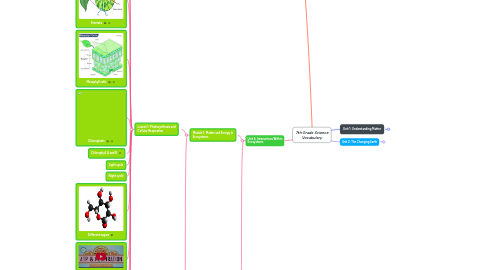
1. Unit 3: Earth's Resources
1.1. Module 1: Distribution of Earth's Resources
1.1.1. Lesson 1: Natural Resources
1.1.1.1. Natural Resources
1.1.1.2. Ores
1.1.1.3. Renewable Resources
1.1.1.4. Non--renewable Resources
1.1.2. Lesson 2:
1.1.2.1. Hydrothermal deposits
1.1.2.2. Subduction Zones
1.1.2.3. Distribution of minerals
1.1.2.4. Soil
1.1.2.5. 5 Factors of soil formation
1.1.2.6. Formation of Coal
1.1.2.7. Formation of Oil and Natural Gas
1.1.2.8. Porosity
1.1.2.9. Permeability
1.1.2.10. Groundwater
1.1.2.11. Groundwater distribution
1.1.3. Lesson 3:
1.1.3.1. Mining
1.1.3.2. Dwindling Deposits
1.1.3.3. Mineral Supplies
1.1.3.4. Fossil fuel extraction
1.1.3.5. Groundwater overdraft
1.2. Module 2: Materials Science
1.2.1. Lesson 1: Synthetic Technology
1.2.1.1. Material
1.2.1.2. Natural Material
1.2.1.3. Synthetic Material
1.2.1.4. Reactants To Products
1.2.2. Lesson 2: Synthetic Materials And Societal Impact
1.2.2.1. Natural Resource Availability
1.2.2.2. Synthetic Material Production
1.2.2.3. Individual And Societal Impacts
1.2.2.4. By-Products
2. Unit 4: Interactions Within Ecosystems
2.1. Module 1: Matter and Energy in Ecosystems
2.1.1. Lesson 1: Photosynthesis and Cellular Respiration
2.1.1.1. Photosynthesis
2.1.1.2. Epidermal leaf cells
2.1.1.3. Cuticle
2.1.1.4. Stomata
2.1.1.5. Mesophyll cells
2.1.1.6. Chloroplasts
2.1.1.7. Chlorophyll A and B
2.1.1.8. Light cycle
2.1.1.9. Night cycle
2.1.1.10. Different sugars
2.1.1.11. Cellular Respiration
2.1.1.12. Glycolysis
2.1.1.13. Mitochondria
2.1.1.14. Lactic acid fermentation
2.1.1.15. Ethanol alcohol fermentation
2.1.2. Lesson 2: Flow Of Energy
2.1.2.1. Producers
2.1.2.2. Consumers
2.1.2.3. Detritivores
2.1.2.4. Food Chain
2.1.2.5. Food Web
2.1.2.6. Energy Pyramid
2.2. Module 2: Dynamic Ecosystems
2.2.1. Lesson 1: Resources In Ecoystems
2.2.1.1. Biosphere
2.2.1.2. Biome
2.2.1.3. Ecosystems
2.2.1.4. Communities
2.2.1.5. Populations
2.2.1.6. Organism
2.2.1.7. Abiotic
2.2.1.8. Biotic
2.2.1.9. Limiting Factor
2.2.1.10. Biotic Potential
2.2.1.11. Carrying Capacity
2.2.1.12. Overpopulation
2.2.1.13. Extinction
2.2.1.14. Endangered Species
2.2.1.15. Threatened species
2.2.2. Lesson 2: Interactions Within Ecosystems
2.2.2.1. Symbiosis
2.2.2.2. Commensalism
2.2.2.3. Parasitism
2.2.2.4. Mutualism
2.2.2.5. Cooperative Relationships
2.2.2.6. Competitive Relationship
2.2.2.7. Predator-prey relationship
2.2.3. Lesson 3: Changing Ecosystems
2.2.3.1. Ecological succession
2.2.3.2. Climax Community
2.2.3.3. Primary succession
2.2.3.4. Secondary succession
2.2.3.5. Eutrophication
2.2.3.6. Dynamic Equilibrium
2.2.3.7. Resource Extraction
2.2.3.8. Pollution
2.2.3.9. Nonnative species
3. Unit 1: Understanding Matter
3.1. Module 2: Matter: Properties and Changes
3.1.1. Lesson 1: Properties Of Matter
3.1.1.1. Qualitative Characteristics
3.1.1.2. Quantitative Characteristics
3.1.1.3. Mass
3.1.1.4. Weight
3.1.1.5. Volume
3.1.1.6. Density
3.1.1.7. Chemical Properties
3.1.1.8. Flammability
3.1.1.9. Oxidation
3.1.1.10. Reactivitity
3.1.1.11. Solubility
3.1.2. Lesson 2: Property Changes In Chemical Reactions
3.1.2.1. Chemical changes
3.1.2.2. Chemical reactions
3.1.2.3. Chemical equations
3.1.2.4. Products
3.1.2.5. Reactants
3.1.2.6. Coefficents
3.1.2.7. Antoine Lavoisier
3.1.2.8. Law of conservation of mass
3.1.2.9. Atomic mass
3.1.3. Lesson 3: Energy Changes In Chemical Reactions
3.1.3.1. Chemical Potential Energy
3.1.3.2. Endothermic Reaction
3.1.3.3. Exothermic Reaction
3.1.3.4. Concentrations In reactions
3.1.3.5. law of conservation of energy
4. Unit 2: The Changing Earth
4.1. Module 1: Dynamic Earth
4.1.1. Lesson 1: Moving Continents
4.1.1.1. Pangea
4.1.1.2. Continental Drift
4.1.1.3. Rock Formation Evidence
4.1.1.4. Glacial Features Evidence
4.1.1.5. Coal Deposit Evidence
4.1.1.6. Fossil Evidence
4.1.1.7. Alfred Wegener
4.1.2. Lesson 2: Development Of A Theory
4.1.2.1. Ocean Floor Topography
4.1.2.2. Mid Ocean Ridges
4.1.2.3. Ocean Trenches
4.1.2.4. Isochron Maps
4.1.2.5. Seafloor Spreading
4.1.2.6. Magma
4.1.2.7. Lava
4.1.2.8. Plate Tectonics
4.1.3. Lesson 3: Shaping Earth's Surface
4.1.3.1. Convergent Boundary
4.1.3.2. Divergent Boundary
4.1.3.3. Transform Boundary
4.1.3.4. Subduction
4.1.3.5. Fault
4.1.3.6. Fault Block Mountains
4.1.3.7. Volcano
4.1.3.8. Volcanic Arc
4.1.3.9. Earthquake
4.1.3.10. Fault Zone
4.1.3.11. Landslide
4.1.3.12. Tsunami
4.1.3.13. Impact Crater
4.1.4. Lesson 4: Changing Earth's Surface
4.1.4.1. Physical Weathering
4.1.4.2. Frost Wedging
4.1.4.3. Plant Action
4.1.4.4. Abrasion
4.1.4.5. Wind Abrasion
4.1.4.6. Water Abrasion
4.1.4.7. Glacial Abrasion
4.1.4.8. Chemical Weathering
4.1.4.9. Oxidation
4.1.4.10. Hydrolosis
4.1.4.11. Carbonation
4.1.4.12. Erosion
4.1.4.13. Deposition
4.1.4.14. Small Scale Erosion
4.1.4.15. Surface Runoff
4.1.4.16. Coastal Erosion
4.1.4.17. Large Scale Erosion
4.1.4.18. Mass Wasting
4.1.4.19. Glacial Movement
4.1.5. Lesson 5: The Cycling Of Earth's Materials
4.1.5.1. Rock
4.1.5.2. Mineral
4.1.5.3. Crystallization
4.1.5.4. Igneous Extrusive Rock
4.1.5.5. Igneous Intrusive Rock
4.1.5.6. Sedimentary Rock
4.1.5.7. Lithification
4.1.5.8. Compaction
4.1.5.9. Cementation
4.1.5.10. Metamorphic Rock
4.2. Module 2: Natural Hazards
4.2.1. Lesson 1: Earthquakes
4.2.1.1. Earthquakes and Plate Boundaries
4.2.1.2. Richter Magnitude Scale
4.2.1.3. Earthquake Magnitude
4.2.1.4. Moment Magnitude Scale
4.2.1.5. Modified Mercalli Intensity Scale
4.2.1.6. Pancaking
4.2.1.7. Liquefication
4.2.1.8. Landslide
4.2.1.9. Tsunami
4.2.2. Lesson 2: Volcanoes
4.2.2.1. Volcano Belts
4.2.2.2. Hot Spots
4.2.2.3. Mudflows
4.2.2.4. Lava Flows
4.2.2.5. Volcanic Ash
4.2.2.6. Volcanic Gases
4.2.2.7. Pyroclastic Flows
4.2.2.8. Predicting Volcanoes - Gas
4.2.2.9. Predicting Volcanoes - Deformation
4.2.2.10. Predicting Volcanoes - Ground Vibration
4.2.2.11. Predicting volcanoes - Remote Sensing
4.2.2.12. Predicting Volcanoes - Lava Collection
4.2.3. Lesson 3: Severe Weather
4.2.3.1. Hurricane
4.2.3.2. Saffir-Simpson Hurricane Scale
4.2.3.3. Tornado
4.2.3.4. Enhanced Fujita Damage Intensity Scale
4.2.3.5. Flood
4.2.3.6. Drought
4.2.3.7. Drought Hazard - Soil Erosion
4.2.3.8. Drought Hazard - Wildfires
4.2.3.9. Drought Hazard - Decrease In Water Supply
4.2.3.10. Drought Hazard - Agricultural Impact
4.2.3.11. Meteorologists
